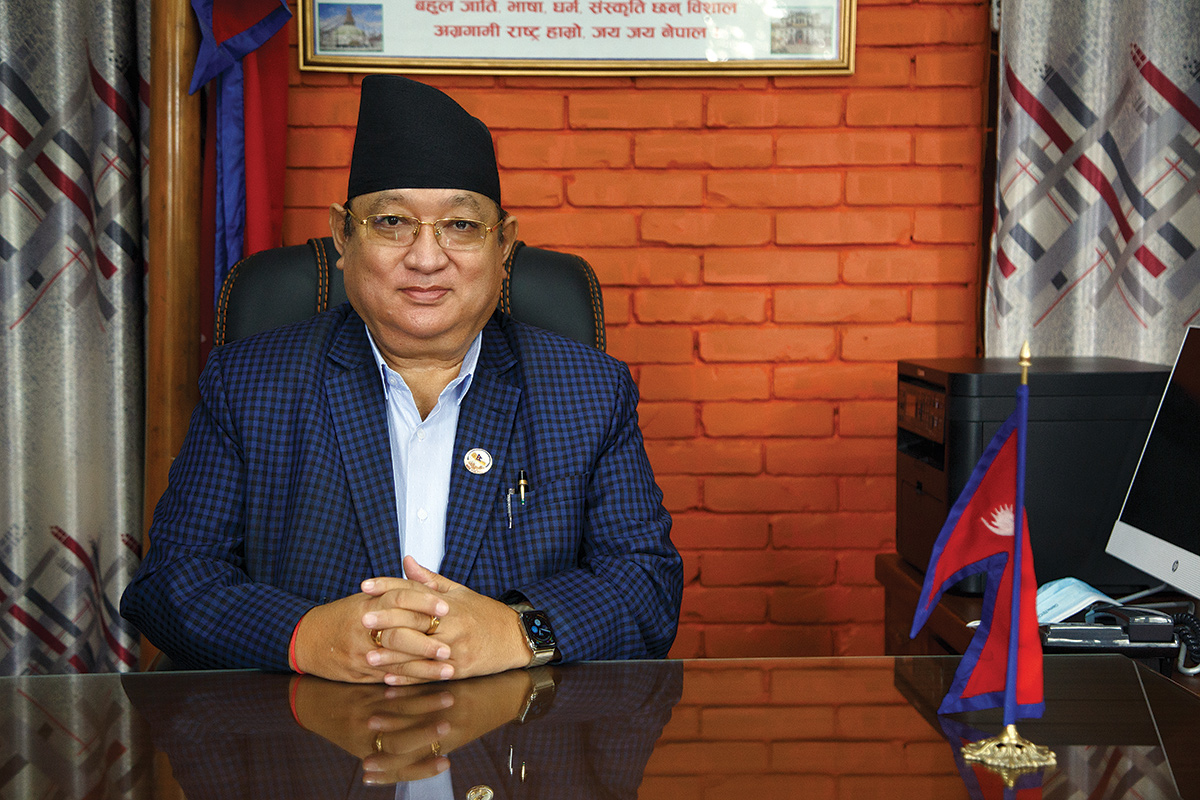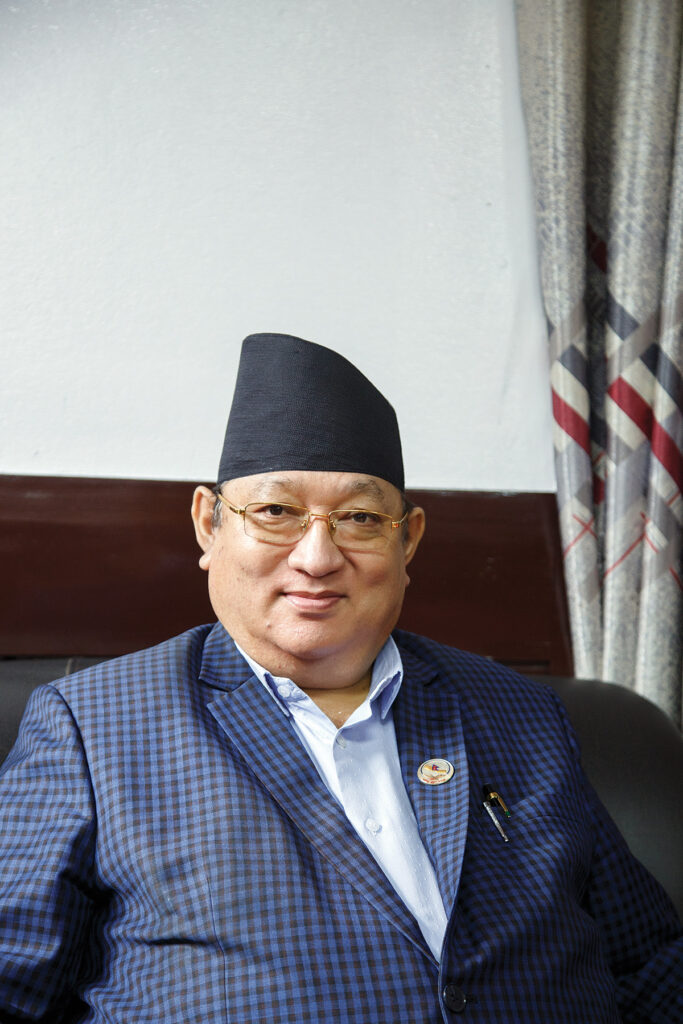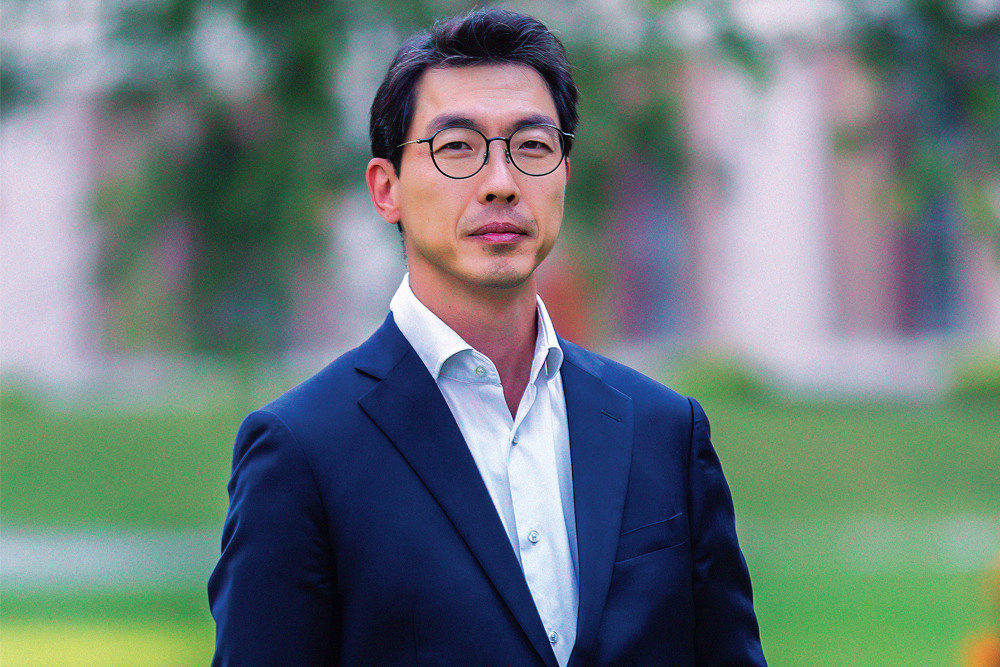
Nepal has been facing a multi-pronged crisis due to the Covid 19 pandemic both on public health and economic fronts. Although the graph for infections has witnessed a slowdown in recent days, the average rate currently remains roughly around 10%. The coalition government led by Nepali Congress President Sher Bahadur Deuba while assuming responsibility has promised that the one and only priority of the government is to vaccinate all Nepalis by mid-April 2022; and vaccinate one-third of the population by mid-October this year. To execute the government’s most important agenda, the Deuba-led government has appointed Umesh Shrestha as State Minister for Health and Population. Business 360 caught up with State Minister Shrestha to learn about the achievements and challenges in the current government’s fight against Covid 19. Excerpts:

The government has given high priority to vaccinate the entire population by mid-April 2022. Will this goal be achieved within the stipulated timeframe?
We are moving ahead on the right track to achieve this goal as 11,782,181 Nepalis have already been vaccinated against Covid 19. Of this total, 5,578,865 have been fully vaccinated so far (till September 19). Around 40% of the population living in Kathmandu valley has been fully vaccinated and this has substantially lowered the transmission as there are less chances of the virus being transmitted when people are vaccinated. We have been bringing vaccines through different sources and recently our northern neighbour delivered 4.4 million doses of Covid 19 jabs which we are going to distribute countrywide in an equitable manner. From September 20, vaccines are being administered to all from 18 years+ age group in Taplejung, Sankhuwasabha, Solukhumbu, Rasuwa, Jumla, Mugu, Humla, Dolpa, Bajura and Darchula. In Kavre and Chitwan, people in age group of 35+ can receive the jabs. Similarly, people from age group of 40 years+ will be vaccinated in Kathmandu, Lalitpur, Bhaktapur, Makawanpur, Ramechhap, Sarlahi and Achham; and those who are 45 years and above will be vaccinated in the remaining 55 districts. Meanwhile, three districts, namely Manang, Mustang and Rukum East are already declared fully vaccinated. Most importantly, during this phase of the vaccination drive there will be no restriction for students who are 18 and above to get their Covid 19 jabs from any vaccine centre.How are you going to manage the quantities?
As we announced while forming the government we have given priority to purchasing vaccines from all available sources. So far, China has been the major contributor. The previous government had purchased four million jabs and the Chinese government had provided 1.8 million jabs initially on grant in two phases. Later, after the formation of the new government, China has offered grant of 1.6 million doses as a goodwill gesture and we have signed an agreement to purchase six million doses, of which 4.4 million have been received recently. The United States, India, Japan and the UK have provided us 1.53 million, 1.1 million, 1.61 million and 1.3 lakh vaccines, respectively. The American government provided us the single-shot J&J vaccines which helped us to increase the number of people who are inoculated as other vaccines require two doses and it takes time in between the vaccinations. These vaccines were received as grant through the United Nations COVAX facility to ensure equitable distribution of vaccines. COVAX has promised to supply vaccines that will be sufficient to vaccinate 12.6 million or 20% of our population. However, the COVAX programme has faced an adverse impact after the second wave wrecked India which was supposed to be the largest contributor to COVAX. So far, we have received 3.48 lakh doses of vaccines from COVAX. The previous government had sealed a deal to purchase two million jabs from India’s Serum Institute. We have received only half of the agreed quantity and we are corresponding with the Indian government to avail another one million jabs. India has lifted its ban on vaccine export and we will also try to purchase from the southern neighbour. In the next phase, we will prioritise vaccinating adolescents in the age bracket of 12 to 18 years and for this we have also signed a deal to purchase four million vaccines manufactured by Moderna through COVAX on a cost-share option which means we’ll get the vaccines at a rate which will be similar to that of GAVI, global vaccine alliance. We have also signed a deal to purchase six million Pfizer vaccines and they will be delivered starting from March next year. Roughly 20% of the population has been vaccinated so far. The speed of vaccination has not been encouraging as we lack storage facilities and a cold storage chain. Your opinion. We had a target to vaccinate 21,757,763 people and more than half of the targeted population has received their vaccines. From September 20 we have opened up first dose vaccination for another age bracket from 35 years to 45 years in different districts. Nepal has made tangible progress in the front of vaccination as compared to other countries in South Asia: India (14%), Bangladesh (9%) and Pakistan (10.7%). Maldives, Sri Lanka and Bhutan have more progress compared to other South Asian nations. We have also received a congratulatory note from the World Health Organisation for the progress that we achieved in a short period of time. Vaccination is very important as we have set a target to open up various sectors of the economy like tourism, trade and transportation which require people to move around. Moreover, these sectors are very important to our economy mainly in the urban and semi-urban areas. During an interaction with the private sector, we have expressed commitment that we’ll vaccinate people of priority sectors as early as possible. The pandemic has caused manifold challenges in the economy and I can sense the plight of the private sector, employees, and daily wage labourers. The incumbent government has given due priority to end the plight and uncertainty caused by the Covid 19 pandemic and bring back the country to pre-pandemic normalcy.
We have already started expanding storage capacity and developing a cold storage chain across the country because we are going to bring Moderna and Pfizer vaccines which will be distributed across the country.
With major festivals around the corner, there will definitely be an increase in domestic as well as cross-border movement of people. What is the government doing to avoid the risk of a rise in Covid 19 infections, and also addressing the Nipah virus? We are aware of this and are adopting preventive measures to keep people safe. However, people should also be aware of the dangers and adopt safe behaviour and all necessary health protocols. Besides, we are coordinating with the Covid 19 Crisis Management Centre (CCMC) to set up holding centres at the borders with testing and isolation facilities. We must all be aware that we could contract the virus if we visit crowded places and are careless. You might have to pay heavily for your negligence which is why we have to be sincere to keep others safe. Even if a person is fully vaccinated they should continue following health safety measures because fully vaccinated people have also been infected. None of the vaccines are 100% effective but it has been proven that all Covid 19 vaccines approved by WHO are safe and vaccination reduces Covid 19 related hospitalisation. The recent sero-prevalence survey conducted by the Ministry of Health and Population (MoHP) has revealed Covid 19 antibody in 68.6% of the samples. It means if we are aware and follow health safety protocols we will be getting rid of the second wave in the near future. Daily active Covid 19 cases are gradually coming down, recovery rate is 95.5% and fatality rate is 1.5%. Having said that I would also like to stress that if we start being negligent then there is not only the risk of Covid 19 spread but also the Nipah virus. The recent research has said the chance of a third wave is slim but we have expanded health services, ICU/HDU beds, ventilators, oxygen capacity to be prepared for the third wave if it does come. We have 7,984 isolation beds; 3,234 HDU beds; 2,733 ICU beds; 1,036 ventilators; 74 oxygen plants and 19 oxygen tanks with capacity of producing 4,053 litres per minute (LPM) and 1,679 oxygen concentrators.What are your plans to reform Nepal’s health sector which was severely lacking during the pandemic?
As the state minister of health I have been making conscious efforts to reform the country’s health sector. As we are in a critical juncture of public health crisis, public perception towards the government is developed based on the performance of the Ministry of Health and Population and I have interacted with my team in the ministry accordingly and instructed them to multiply their efforts to serve people in need. We can’t be procrastinating in government service delivery. I have laid emphasis on reform of government hospitals. We don’t have to actually reinvent the wheel to bring reforms. We can do so by tightening the screws. Just a few days back, all the medical directors of government hospitals were summoned to the ministry and I have clearly told them to report directly to me if they are facing any problems whether it be procurement or transfer of staffs or anything else. We need to change the image of the government hospitals. I will do my best to solve their problems and if any problem cannot be resolved from my end I will hold consultations with the higher political leadership. I am committed towards reforming the health sector to ensure all people from any corner of the country can access affordable and quality health care. In this regard, government hospitals are the face of health services in the country and we are committed to bring change in the image of government hospitals. What I have learnt in my 42 years as an entrepreneur is that we have to be passionate about achieving targets and I have conviction to bring change in the health sector.How can the government ensure affordable and quality healthcare to every Nepali?
The Public Health Service Act, 2018 has provisioned ten types of health services as free basic health services and these have been defined as fundamental rights in the constitution. These are: vaccination service, motherhood, infant and paediatric health service such as integrated infant and paediatric disease management, nutrition service, pregnancy, labour and child birth service, family planning, abortion and reproductive health; service related to communicable disease; service related to non-communicable disease and physical disability; service related to mental disease; service related to elderly citizen’s health; service of general emergency condition; health promotion service; ayurveda and other accredited alternative health service; and other services prescribed by the Government of Nepal through a notification in the Nepal Gazette. To execute the law, we must be equipped with needful resources. The government has been distributing 70 types of life-saving drugs for free and bearing the cost of treatment of catastrophic diseases such as cancer, heart, kidney, head injury, sickle cell anaemia, spinal injury, Parkinson’s, and Alzheimer. Currently, the government has been providing services through government and some private hospitals under the government scheme to treat patients battling with serious diseases. To make health care more affordable and minimise the government’s liability the government has launched insurance schemes at nominal premiums. Read this also:A Rising Culture of Middle-Class Angel Investors Are Enriching Themselves and Society
Published Date: September 27, 2021, 12:00 am
Post Comment
E-Magazine
RELATED Face 2 Face



.jpg)
.jpg)
.jpg)